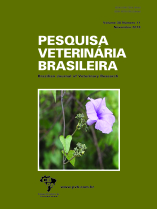 |
|
|
|
Year 2018 - Volume 38, Number 11
|

|
Experimental poisoning in broiler chickens by Senecio vernonioides, Senecio conyzaefolius and Senecio paulensis, 38(11):2065-2069
|
ABSTRACT.- Biffi C.P., Savaris T., Parizoto L.H., Ogliari D., Boreli V., Emmerich T., Gardner D. & Gava A. 2018. Experimental poisoning in broiler chickens by Senecio vernonioides, Senecio conyzaefolius and Senecio paulensis. [Intoxicação experimental em frangos de corte por Senecio vernonioides, Senecio conyzaefolius e Senecio paulensis.] Pesquisa Veterinária Brasileira 38(11):2065-2069. Laboratório de Patologia Animal, Centro de Ciências Agroveterinárias, Universidade do Estado de Santa Catarina, Av. Luiz de Camões 2090, Conta Dinheiro, Lages, SC 88520-000, Brazil. E-mail: aldo.gava@udesc.br
Plants of the genus Senecio sp. are known to produce hepatic lesions in different animal species, including man. To evaluate the toxicity of three species of Senecio found in regions where cattle are bred in the state of Santa Catarina, experiments were conducted on broiler chickens (Gallus domesticus). Green leaves of S. conyzaefolius, S. vernonioides and S. paulensis were collected and dried in the shade. After drying, the leaves were ground, mixed into the feed and fed to the chickens divided into 3 groups. Group 1 and Group 2 received single doses of 5g/kg and 20g/kg, respectively. Group 3 was given daily doses of 1g/kg for 20 days (values corresponding to green plant) and Group 4 (control) received free feed of the plant. For each group, five chickens were submitted to necropsy at 30 days and five to 60 days after planting, and five chickens that consumed S. vernonioides and S. conyzaefolius at the dose of 1g/kg for 20 days were necropsied at 90 days after the beginning of the experiment. Macroscopic lesions were observed in chickens that consumed S. vernonioides at a dose of 1 g/kg for 20 days in birds necropsied at 30, 60 and 90 days and were characterized mainly by liver of firm consistency, diminished in size with yellowish coloration and evident lobular pattern, ascites and hydropericardium. In microscopy the main lesions observed were megalocytosis, hepatocyte swelling, fibrosis and biliary hyperplasia and were more intense at the dosage of 1 g/kg for 20 days for S. vernonioides and less severe in the chickens that ingested S. conyzaefolius. The chickens that received S. paulensis showed no macroscopic and microscopic lesions. |
| |
|
|
| |
|
 |